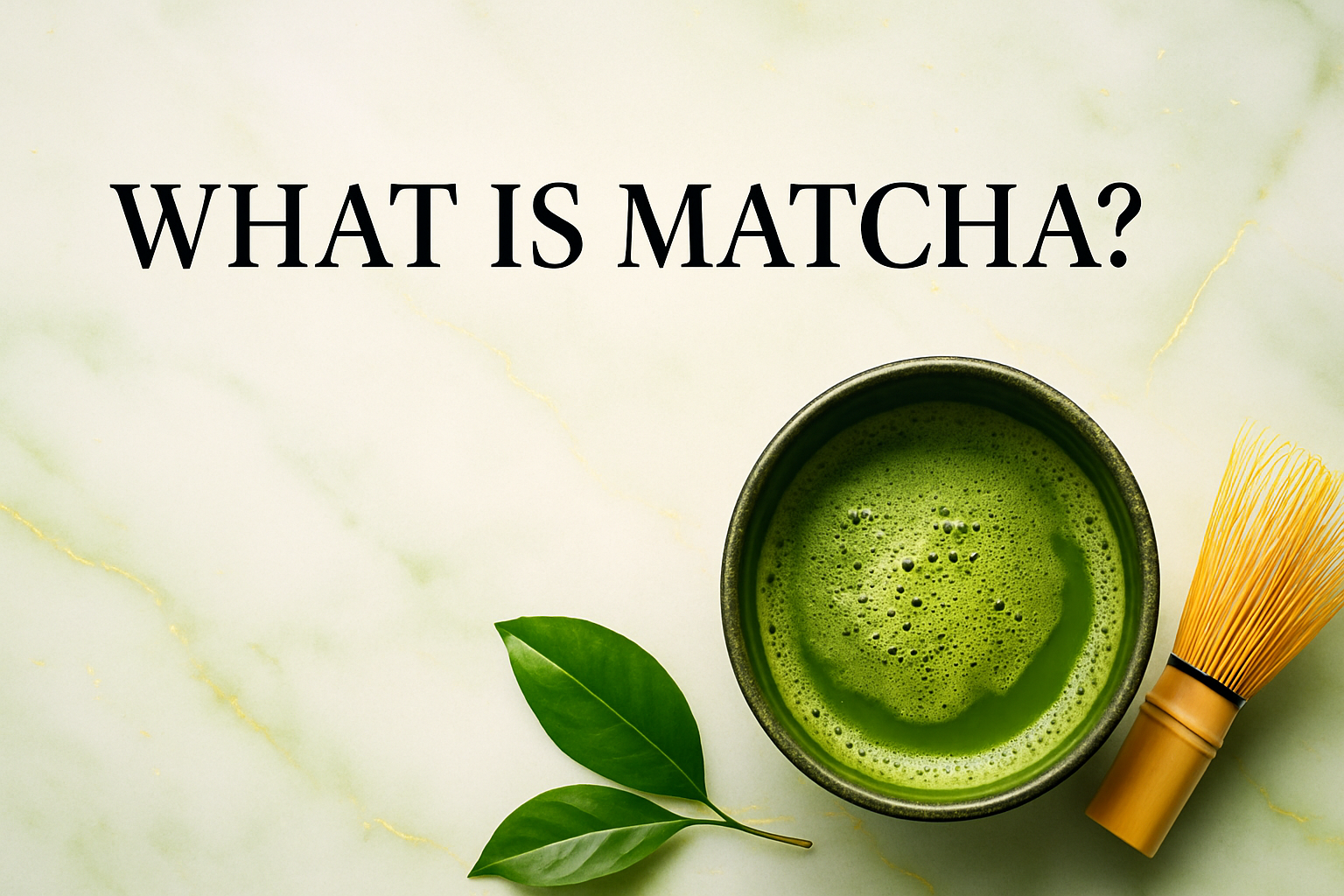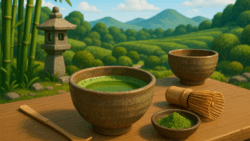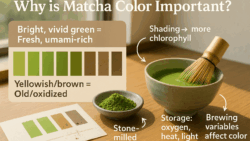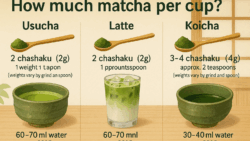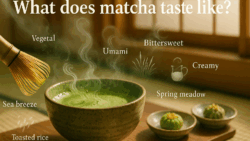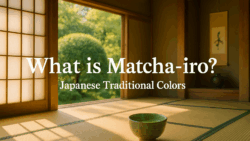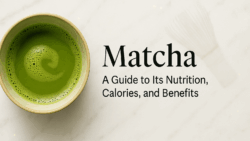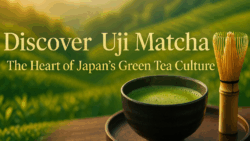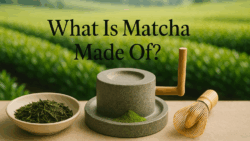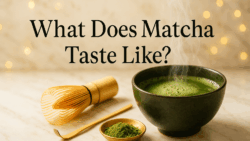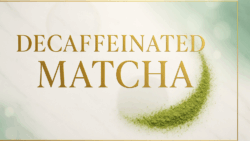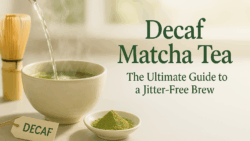- What is Matcha? Discover a World of Vibrant Green Tea
- The Rich History of Matcha
- Matcha vs. Green Tea: What’s the Real Difference?
- Explore the Amazing Health Benefits of Matcha
- A Guide to Matcha Grades: Ceremonial vs. Culinary
- How to Make Your First Perfect Cup of Matcha
- Essential Tools for the Best Matcha Experience
- So, What Does Matcha Actually Taste Like?
- How to Choose a High-Quality Matcha Powder
- Beyond the Tea: More Fun Ways to Enjoy Matcha
What is Matcha? Discover a World of Vibrant Green Tea
Matcha is a special type of green tea, famous for its brilliant green powder. The process for making it is what sets it apart. Tea plants destined to become matcha are grown in the shade for several weeks before harvest. This boosts their chlorophyll, giving the powder its vivid color. After harvesting, farmers carefully remove the stems and veins. The best parts of the leaf are then stone-ground into a silky, delicate powder. What makes matcha so unique? When you drink it, you are enjoying the entire tea leaf, not just water steeped with leaves. This means you get a concentrated wave of antioxidants and other healthy compounds in every sip.
The Rich History of Matcha
Matcha’s story began in China, but it was in Japan where it truly became an art form. A Zen Buddhist monk brought the tradition to Japan in the late 12th century. There, preparing and drinking powdered green tea became a central part of spiritual rituals in monasteries. Over centuries, this practice grew into the beautiful and respected Japanese tea ceremony, “Chanoyu.” This ceremony transformed matcha from a simple drink into an expression of harmony, respect, and mindfulness. The Uji region near Kyoto became world-famous for its perfect climate and soil, producing the highest quality matcha. Today, Uji is still the gold standard for matcha lovers.
Matcha vs. Green Tea: What’s the Real Difference?
While both come from the same Camellia sinensis plant, matcha and regular green tea couldn’t be more different. First, look at how they’re grown. Matcha plants are shade-grown, while green tea plants grow in direct sun. This shading boosts an amino acid called L-theanine, which gives matcha its unique savory (umami) flavor and calming effect. The processing is also worlds apart. For matcha, only the best leaves are chosen, de-stemmed, de-veined, and ground into powder. For regular green tea, the leaves are simply rolled and dried. The biggest difference is how you drink them. You steep green tea leaves in water, but you whisk matcha powder directly into water, enjoying every part of the leaf.
Explore the Amazing Health Benefits of Matcha
Matcha is more than just a delicious drink—it’s a powerhouse of wellness! It’s packed with antioxidants, especially one called EGCG, which helps protect your body’s cells from damage. Matcha also offers a unique kind of energy. It contains caffeine, but it’s balanced with high levels of L-theanine. This amazing combination gives you sustained energy and a feeling of calm, focused alertness, without the anxious jitters you can get from coffee. Studies also suggest matcha can support a healthy metabolism, and its high chlorophyll content is believed to have detoxifying effects.
A Guide to Matcha Grades: Ceremonial vs. Culinary
Not all matcha is the same! Let’s explore the two main grades you’ll find. The first is Ceremonial Grade. This is the absolute best quality, made from the youngest tea leaves at the top of the plant. It has a super-fine texture, a brilliant green color, and a naturally sweet, delicate flavor. Ceremonial grade is meant to be enjoyed on its own, simply whisked with hot water. The second is Culinary Grade. This matcha is made from leaves harvested a bit later, giving it a stronger, bolder flavor that can be slightly more bitter. This makes it perfect for mixing into lattes, smoothies, baked goods, and other creative recipes.
How to Make Your First Perfect Cup of Matcha
Preparing matcha is a simple, mindful ritual you can easily enjoy at home. You’ll need matcha powder and hot water. Make sure the water is hot but not boiling (about 175°F or 80°C is perfect), as boiling water can make the tea taste bitter. First, sift 1-2 teaspoons of matcha into a bowl to get rid of any clumps. This is the secret to a silky-smooth drink! Next, add just a splash of hot water (about two ounces). Now, whisk briskly in a zigzag or “W” motion. A bamboo whisk is traditional, but a small kitchen whisk or electric frother works great too! Keep whisking until the tea is smooth and a layer of fine foam appears on top. It’s now ready to enjoy straight from the bowl! Feel free to add more water or your favorite milk to taste.
Essential Tools for the Best Matcha Experience
While you don’t need special tools, a few traditional items can make your matcha ritual even better. A Chawan (tea bowl) has a wide, flat bottom that makes whisking easy. A Chasen (bamboo whisk) has dozens of tiny prongs designed to dissolve the powder perfectly and create a beautiful foam. A Chashaku (bamboo scoop) helps you measure out the powder. Using these tools connects you to the rich history of matcha. We also highly recommend a small, fine-mesh sifter—it’s the easiest way to guarantee a lump-free cup every time.
So, What Does Matcha Actually Taste Like?
The flavor of matcha is complex and wonderful. High-quality matcha isn’t bitter. Instead, it has a rich, smooth, and slightly grassy taste, often with notes of spinach or edamame. This is balanced by a pleasant savory flavor known as umami—the “fifth taste.” The best ceremonial grade matcha also has a subtle, natural sweetness that lingers on your palate. When whisked properly, the texture is incredibly creamy and smooth. Overall, it’s a clean and refreshing experience. Culinary grade matcha has a stronger, bolder taste, which is why it stands up so well to milk and sugar in lattes and baked treats.
How to Choose a High-Quality Matcha Powder
Ready to buy your own matcha? Here are a few simple tips to find the good stuff. First, look at the color. It should be a brilliant, electric green. Dull or yellowish-green powder is a sign of a lower-quality product. Second, check the origin. The best matcha comes from Japan, so look for products that name their region—Uji and Nishio are top-tier. Third, notice the texture. It should feel as fine and silky as talcum powder. Finally, consider the price. Making authentic matcha is a lot of work, so it isn’t cheap. Be wary of very low prices, as they often mean you’re not getting the real deal.
Beyond the Tea: More Fun Ways to Enjoy Matcha
Matcha is an incredibly versatile ingredient you can use in countless creative ways! A matcha latte is a classic favorite, blending a shot of matcha with steamed milk and a hint of sweetener. On a warm day, try an iced matcha latte. You can also add a spoonful of matcha powder to your morning smoothie for a boost of flavor and nutrients. Love to bake? Matcha adds amazing color and taste to cookies, cakes, and brownies. You can even mix it into pancake batter for a special weekend breakfast or sprinkle it over savory noodle dishes.

